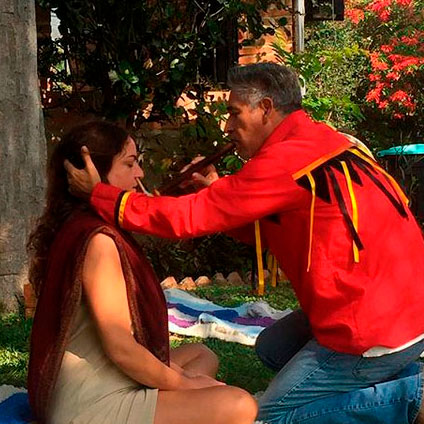Rapé or Hape: An Ancestral Tool for Spiritual Connection and Holistic Well-Being
Tobacco has long been regarded as a sacred shamanic medicine. In Amazonian tribes, it holds a central place in cultural and spiritual traditions, serving as both a spiritual tool and a bridge between the physical and the divine. One of the most fascinating uses of tobacco is through Rapé (pronounced Hapé), a traditional preparation that combines tobacco with ashes from sacred trees. This ceremonial powder, deeply rooted in the indigenous communities of Central and South America, as well as Mexico, has been used for centuries.
The Art of Administering Rapé
What sets Rapé apart from other forms of tobacco is its method of administration. It is neither smoked nor conventionally inhaled; instead, it is blown directly into the nostrils using specialized tools called “kuripe” (for self-administration) or “tepi” (for shared use). This process is carried out with clear intention and purpose, within a ceremonial context that honors the traditions of the indigenous peoples who developed it.
Rapé is a fine, dry gray powder prepared through a ceremonial process that combines tobacco (Nicotiana rustica or Nicotiana tabacum) with ashes from medicinal trees. Commonly used tobacco varieties include “Corda,” “Moi,” and occasionally “Mapacho.” The meticulous preparation results in an exceptionally fine powder, with a texture as fine as 125 microns.
The Properties of Rapé
Rapé is far more than a ritual tool. The potent Nicotiana rustica, stronger and darker than common tobacco (Nicotiana tabacum), induces mental alertness and grounding effects. Meanwhile, the ashes used in its preparation come from the bark of sacred trees, each selected for its medicinal properties.
A Bridge Between Tradition and Well-Being
In the indigenous cultures of the Americas, tobacco is deeply rooted in spiritual practices. For tribes such as the Kaxinawá, Nu-nu, Yawanawá, and Katukina, tobacco has been a key component in ceremonies for healing, weather prediction, vision quests, and strengthening spiritual connections. The use of Rapé dates back to the Mayan civilization, where it served ritual, medicinal, and recreational purposes.
The uses of Rapé in tribal rituals include:
- Puberty and initiation rites
- Community festivals
- Healing ceremonies
- Daily spiritual practices
Each tribe follows its own traditions. Some apply it after breakfast and dinner, while others use it multiple times throughout the night.
The Benefits of Rapé
A typical Rapé ceremony involves mutual administration between two people. The act of blowing Rapé into the nostrils halts mental chatter, focusing the mind and creating an internal space for spiritual intentions to unfold. This process helps release emotional, physical, and spiritual blockages, alleviating negativity and fostering a state of grounding and mental clarity.
Key benefits include:
- Energy realignment: It helps align energy channels, intensify connection with the higher self, and deepen universal awareness.
- Body detoxification: It clears excess mucus, toxins, and bacteria, aiding in the relief of colds and migraines.
- Cognitive stimulation: The nicotine in Rapé activates neurotransmitters such as epinephrine, acetylcholine, and dopamine, enhancing focus, presence, and intuition.
A Mystery to Explore: The Pineal Gland
Some suggest that Rapé could assist in decalcifying the pineal gland, a key organ responsible for melatonin production, circadian rhythm regulation, and medication metabolism. Pineal gland calcification has been linked to neurodegenerative diseases like Alzheimer’s and fluoride exposure. While scientific studies on this potential benefit are still in early stages, it opens intriguing possibilities for exploring human potential and the manifestation of inner light.
Rapé is not merely a ritual tool; it is an ancestral legacy that weaves together ancient wisdom, spirituality, and well-being. For those seeking a deeper connection with themselves and the universe, this sacred powder offers a transformative experience. When used consciously and with respect for its origins and ceremonial purpose, Rapé can open pathways to a more balanced and fulfilling life.

